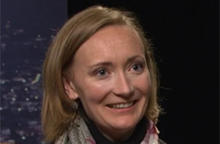Faculty Research Profile: Leslie Harkema on turn-of-the-century Spanish literature

Scholars of twentieth-century European literature have long considered the importance of youth and youth culture within modernist literature. In a recent book, Professor Leslie Harkema seeks to bring turn-of-the-century Spanish literature into this conversation. In Spanish Modernism and the Poetics of Youth: From Miguel de Unamuno to La Joven Literatura (2017, University of Toronto Press), Harkema explores the idea of youth within the Spanish context. She also traces what youth meant within ideas about Spanish national development.
One of the central figures of the book is Miguel de Unamuno, a writer and public intellectual often associated with Spain’s “Generation of 1898.” Harkema is particularly interested in Unamuno’s relationship with younger writers from a school that referred to itself as “la joven literatura” (“the young literature”). Harkema became interested in Unamuno as a graduate student, when she translated some of his poems into English. Unamuno has largely been studied as a novelist, but while working with his poetry, Harkema “realized that younger writers of the next generation thought about him a lot, and wrote about him, and appreciated his poetry … It turns out that Unamuno wrote constantly about youth and to youth.” Unamuno’s poetry—and younger writers’ engagement with it—offers a new window into the importance of youth within Spanish modernist writing.
According to Harkema, the “poetics of youth” took on a special meaning in the late nineteenth and early twentieth century. Within the context of Spanish imperial decline and political uncertainty, a valorization of youth offered an alternative to linear narratives of national development. Lyric poetry was particularly important within this literary moment: “The poetic form offers a way to resist narrative structures,” Harkema says. “Lyric poetry allowed these poets to contest this sort of linear development to a particular end.”
The politics and poetics of youth were neither simple nor straightforward in twentieth-century Spain. “Unamuno was a source for many different interpretations of youth,” Harkema says. Although the writers of La Joven Literatura coincided ideologically for a brief period of time, they eventually diverged politically. While some became leftists and anti-fascists, others became important figures in Spanish fascism. Harkema contends that ideas of youth played a role in both of these divergent ideologies.
Harkema’s next book will contribute to burgeoning scholarly conversations about multilingualism and translation in modern Spain. She is particularly interested in “the ways that different languages coexist and how they shape what we think of as Iberia in the modern period.” Unamuno’s ideas will play a role in this new project—Unamuno himself was Basque, and he also did some translation work—but Harkema also plans to expand her temporal scope. Her next book will begin at the end of the eighteenth century and extend through the Second Spanish Republic (1931-1936). In her next book, Harkema also plans to incorporate more women writers, who often entered the literary world through translation.
On writing Spanish Modernism and the Poetics of Youth, Harkema said: “I really enjoyed revisiting a central figure in modern Spanish literature.” Due to his impact on so many later writers, Unamuno has become a well-known and somewhat controversial figure in the history of Spanish literature. But his work still offers several avenues for future study. “Unamuno is a writer you can’t really avoid in Spanish literature,” Harkema said. “It’s exciting to me to think about can be done with Unamuno still.”
Written by Hannah Greenwald, second-year PhD student.
